2006 MERCEDES-BENZ SPRINTER fuse
[x] Cancel search: fusePage 113 of 2305

TEST ACTION APPLICABILITY
3WARNING: NEVER OPERATE THE HEATER IN AN ENCLOSED AREA
THAT DOES NOT HAVE EXHAUST VENTILATION FACILITIES. ALWAYS
VENT THE EXHAUST WHEN OPERATING THE HEATER. FAILURE TO
FOLLOW THESE INSTRUCTIONS CAN RESULT IN PERSONAL INJURY
OR DEATH.
WARNING: ALLOW THE HEATER ASSEMBLY TO COOL BEFORE PER-
FORMING A COMPONENT INSPECTION/REPAIR/REPLACEMENT. FAIL-
URE TO FOLLOW THESE INSTRUCTIONS CAN RESULT IN PERSONAL
INJURY OR DEATH.
Turn the ignition on.
With the DRBIIItin Sensors, record the Cabin Heater's or Heater Booster's
Operating Voltage.
NOTE: Check connectors - Clean/repair as necessary.
Disconnect the Cabin Heater or Heater Booster harness connector.
Measure the voltage between the Fused B+ circuit and ground.
Is there more than 1.0 volt difference between the Operating Voltage and the Fused
B+ voltage?All
Ye s!Replace the Cabin Heater Assembly or Heater Booster Assembly
in accordance with the Service Information.
Perform HEATER VERIFICATION TEST - VER 1.
No!Go To 4
100
CABIN HEATER
UNDER VOLTAGE ÐContinued
Page 114 of 2305

TEST ACTION APPLICABILITY
4WARNING: NEVER OPERATE THE HEATER IN AN ENCLOSED AREA
THAT DOES NOT HAVE EXHAUST VENTILATION FACILITIES. ALWAYS
VENT THE EXHAUST WHEN OPERATING THE HEATER. FAILURE TO
FOLLOW THESE INSTRUCTIONS CAN RESULT IN PERSONAL INJURY
OR DEATH.
WARNING: ALLOW THE HEATER ASSEMBLY TO COOL BEFORE PER-
FORMING A COMPONENT INSPECTION/REPAIR/REPLACEMENT. FAIL-
URE TO FOLLOW THESE INSTRUCTIONS CAN RESULT IN PERSONAL
INJURY OR DEATH.
Reconnect the Cabin Heater or Heater Booster harness connector.
Connect a suitable voltmeter to the vehicle's battery. Position the voltmeter where it
can be monitored while operating the DRBIIIt.
Turn the ignition on.
Set the blend control to the max heat position and the mode control to the floor
position.
Start the engine.
Allow the engine to idle.
NOTE: Do not disconnect the vehicle's battery or the heater's main power
supply while the heater is in operation or in run-down mode. Failure to
follow these instructions can result in excess emissions from the heater
during heater operation.
Switch the Cabin Heater or Heater Booster on. If necessary, allow the heater to run
through at least one cycle of operation (approximately 10 minutes), and then turn the
heater off.
With the DRBIIItin Sensors, monitor the voltmeter and the Cabin Heater's or
Heater Booster's Operating Voltage while the heater is operational.
Switch the heater off.
Turn the engine off.
Was there more than 1.5 volts difference between Operating & battery voltage?All
Ye s!Repair the high resistance in the Fused B+ circuit.
Perform HEATER VERIFICATION TEST - VER 1.
No!Replace the Cabin Heater Assembly or Heater Booster Assembly
in accordance with the Service Information.
Perform HEATER VERIFICATION TEST - VER 1.
101
CABIN HEATER
UNDER VOLTAGE ÐContinued
Page 157 of 2305
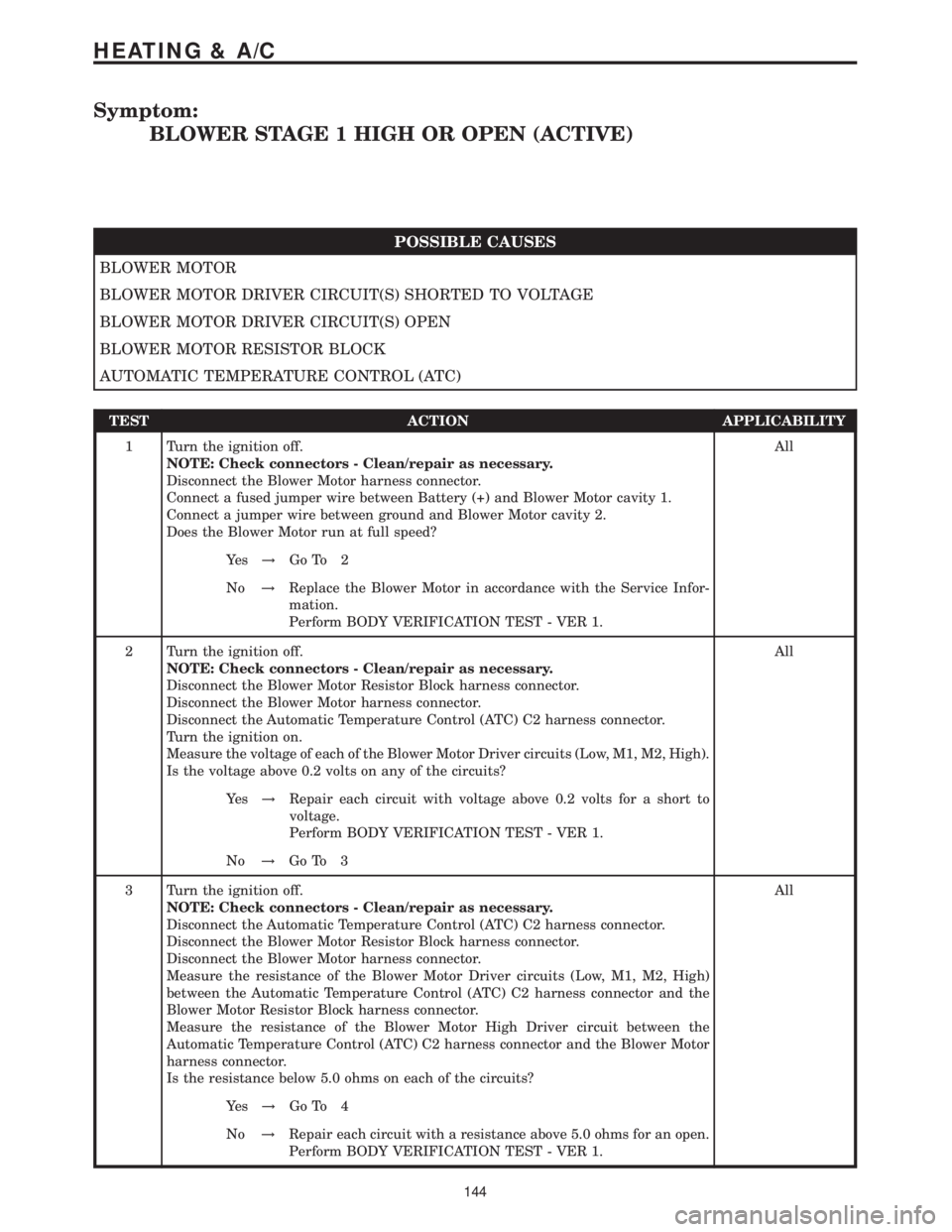
Symptom:
BLOWER STAGE 1 HIGH OR OPEN (ACTIVE)
POSSIBLE CAUSES
BLOWER MOTOR
BLOWER MOTOR DRIVER CIRCUIT(S) SHORTED TO VOLTAGE
BLOWER MOTOR DRIVER CIRCUIT(S) OPEN
BLOWER MOTOR RESISTOR BLOCK
AUTOMATIC TEMPERATURE CONTROL (ATC)
TEST ACTION APPLICABILITY
1 Turn the ignition off.
NOTE: Check connectors - Clean/repair as necessary.
Disconnect the Blower Motor harness connector.
Connect a fused jumper wire between Battery (+) and Blower Motor cavity 1.
Connect a jumper wire between ground and Blower Motor cavity 2.
Does the Blower Motor run at full speed?All
Ye s!Go To 2
No!Replace the Blower Motor in accordance with the Service Infor-
mation.
Perform BODY VERIFICATION TEST - VER 1.
2 Turn the ignition off.
NOTE: Check connectors - Clean/repair as necessary.
Disconnect the Blower Motor Resistor Block harness connector.
Disconnect the Blower Motor harness connector.
Disconnect the Automatic Temperature Control (ATC) C2 harness connector.
Turn the ignition on.
Measure the voltage of each of the Blower Motor Driver circuits (Low, M1, M2, High).
Is the voltage above 0.2 volts on any of the circuits?All
Ye s!Repair each circuit with voltage above 0.2 volts for a short to
voltage.
Perform BODY VERIFICATION TEST - VER 1.
No!Go To 3
3 Turn the ignition off.
NOTE: Check connectors - Clean/repair as necessary.
Disconnect the Automatic Temperature Control (ATC) C2 harness connector.
Disconnect the Blower Motor Resistor Block harness connector.
Disconnect the Blower Motor harness connector.
Measure the resistance of the Blower Motor Driver circuits (Low, M1, M2, High)
between the Automatic Temperature Control (ATC) C2 harness connector and the
Blower Motor Resistor Block harness connector.
Measure the resistance of the Blower Motor High Driver circuit between the
Automatic Temperature Control (ATC) C2 harness connector and the Blower Motor
harness connector.
Is the resistance below 5.0 ohms on each of the circuits?All
Ye s!Go To 4
No!Repair each circuit with a resistance above 5.0 ohms for an open.
Perform BODY VERIFICATION TEST - VER 1.
144
HEATING & A/C
Page 159 of 2305
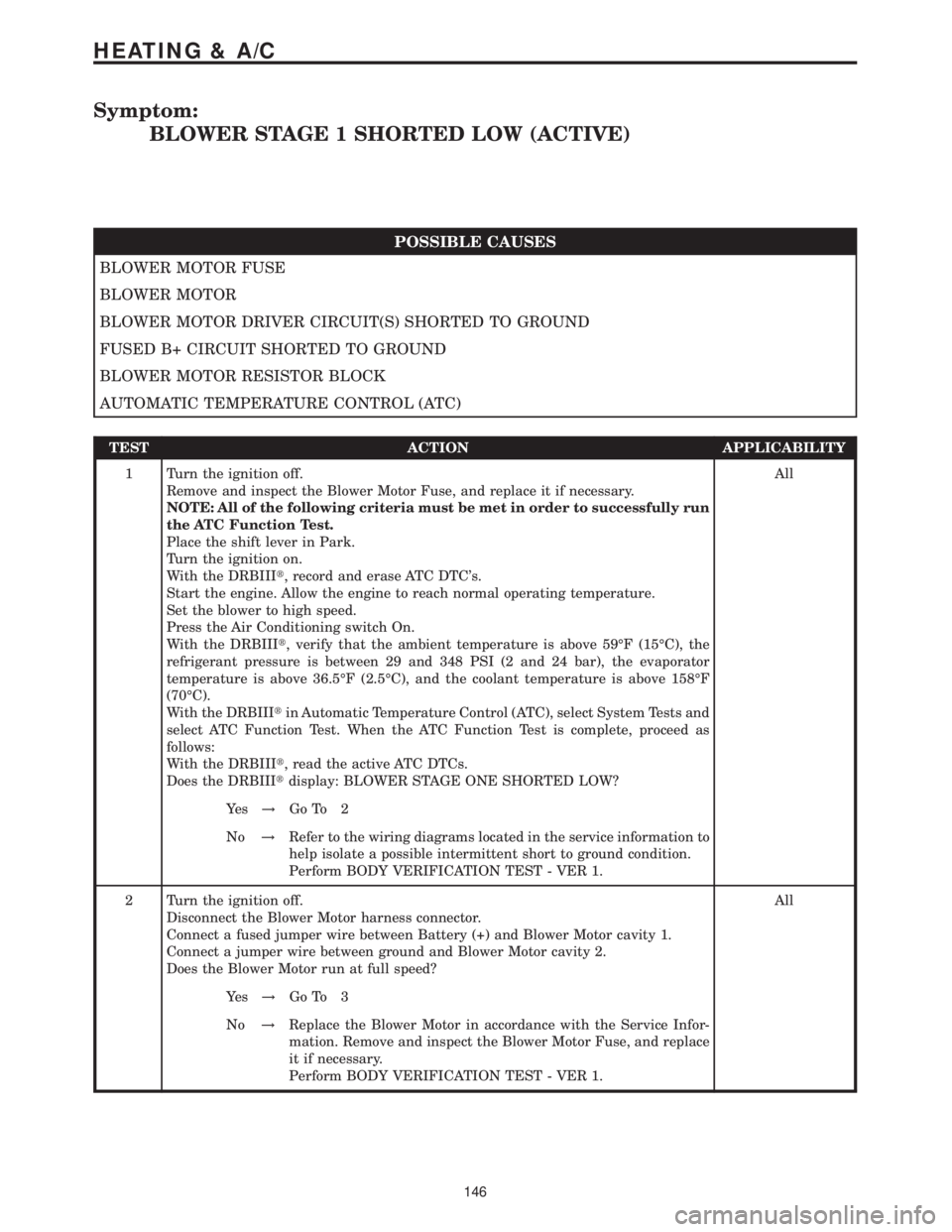
Symptom:
BLOWER STAGE 1 SHORTED LOW (ACTIVE)
POSSIBLE CAUSES
BLOWER MOTOR FUSE
BLOWER MOTOR
BLOWER MOTOR DRIVER CIRCUIT(S) SHORTED TO GROUND
FUSED B+ CIRCUIT SHORTED TO GROUND
BLOWER MOTOR RESISTOR BLOCK
AUTOMATIC TEMPERATURE CONTROL (ATC)
TEST ACTION APPLICABILITY
1 Turn the ignition off.
Remove and inspect the Blower Motor Fuse, and replace it if necessary.
NOTE: All of the following criteria must be met in order to successfully run
the ATC Function Test.
Place the shift lever in Park.
Turn the ignition on.
With the DRBIIIt, record and erase ATC DTC's.
Start the engine. Allow the engine to reach normal operating temperature.
Set the blower to high speed.
Press the Air Conditioning switch On.
With the DRBIIIt, verify that the ambient temperature is above 59ÉF (15ÉC), the
refrigerant pressure is between 29 and 348 PSI (2 and 24 bar), the evaporator
temperature is above 36.5ÉF (2.5ÉC), and the coolant temperature is above 158ÉF
(70ÉC).
With the DRBIIItin Automatic Temperature Control (ATC), select System Tests and
select ATC Function Test. When the ATC Function Test is complete, proceed as
follows:
With the DRBIIIt, read the active ATC DTCs.
Does the DRBIIItdisplay: BLOWER STAGE ONE SHORTED LOW?All
Ye s!Go To 2
No!Refer to the wiring diagrams located in the service information to
help isolate a possible intermittent short to ground condition.
Perform BODY VERIFICATION TEST - VER 1.
2 Turn the ignition off.
Disconnect the Blower Motor harness connector.
Connect a fused jumper wire between Battery (+) and Blower Motor cavity 1.
Connect a jumper wire between ground and Blower Motor cavity 2.
Does the Blower Motor run at full speed?All
Ye s!Go To 3
No!Replace the Blower Motor in accordance with the Service Infor-
mation. Remove and inspect the Blower Motor Fuse, and replace
it if necessary.
Perform BODY VERIFICATION TEST - VER 1.
146
HEATING & A/C
Page 160 of 2305
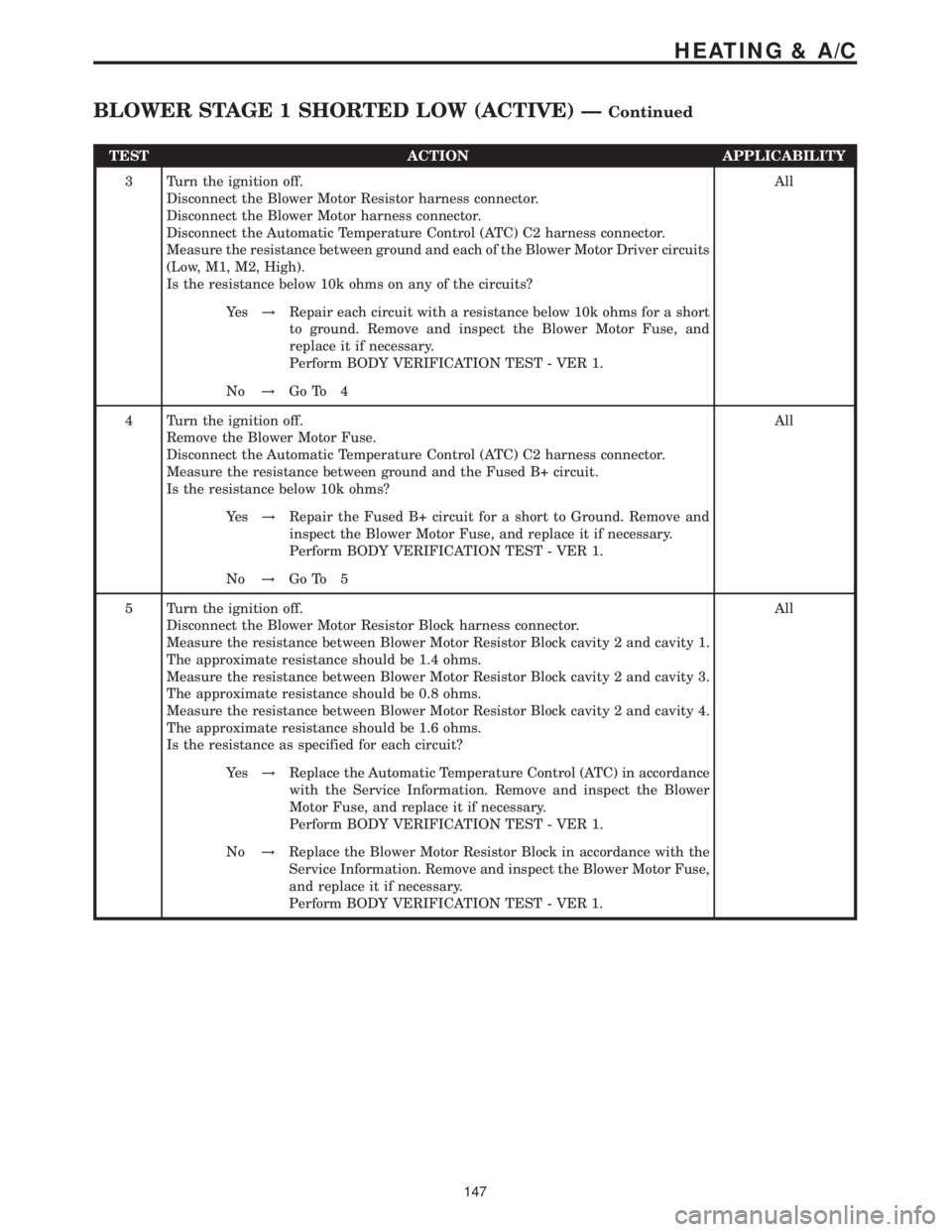
TEST ACTION APPLICABILITY
3 Turn the ignition off.
Disconnect the Blower Motor Resistor harness connector.
Disconnect the Blower Motor harness connector.
Disconnect the Automatic Temperature Control (ATC) C2 harness connector.
Measure the resistance between ground and each of the Blower Motor Driver circuits
(Low, M1, M2, High).
Is the resistance below 10k ohms on any of the circuits?All
Ye s!Repair each circuit with a resistance below 10k ohms for a short
to ground. Remove and inspect the Blower Motor Fuse, and
replace it if necessary.
Perform BODY VERIFICATION TEST - VER 1.
No!Go To 4
4 Turn the ignition off.
Remove the Blower Motor Fuse.
Disconnect the Automatic Temperature Control (ATC) C2 harness connector.
Measure the resistance between ground and the Fused B+ circuit.
Is the resistance below 10k ohms?All
Ye s!Repair the Fused B+ circuit for a short to Ground. Remove and
inspect the Blower Motor Fuse, and replace it if necessary.
Perform BODY VERIFICATION TEST - VER 1.
No!Go To 5
5 Turn the ignition off.
Disconnect the Blower Motor Resistor Block harness connector.
Measure the resistance between Blower Motor Resistor Block cavity 2 and cavity 1.
The approximate resistance should be 1.4 ohms.
Measure the resistance between Blower Motor Resistor Block cavity 2 and cavity 3.
The approximate resistance should be 0.8 ohms.
Measure the resistance between Blower Motor Resistor Block cavity 2 and cavity 4.
The approximate resistance should be 1.6 ohms.
Is the resistance as specified for each circuit?All
Ye s!Replace the Automatic Temperature Control (ATC) in accordance
with the Service Information. Remove and inspect the Blower
Motor Fuse, and replace it if necessary.
Perform BODY VERIFICATION TEST - VER 1.
No!Replace the Blower Motor Resistor Block in accordance with the
Service Information. Remove and inspect the Blower Motor Fuse,
and replace it if necessary.
Perform BODY VERIFICATION TEST - VER 1.
147
HEATING & A/C
BLOWER STAGE 1 SHORTED LOW (ACTIVE) ÐContinued
Page 168 of 2305
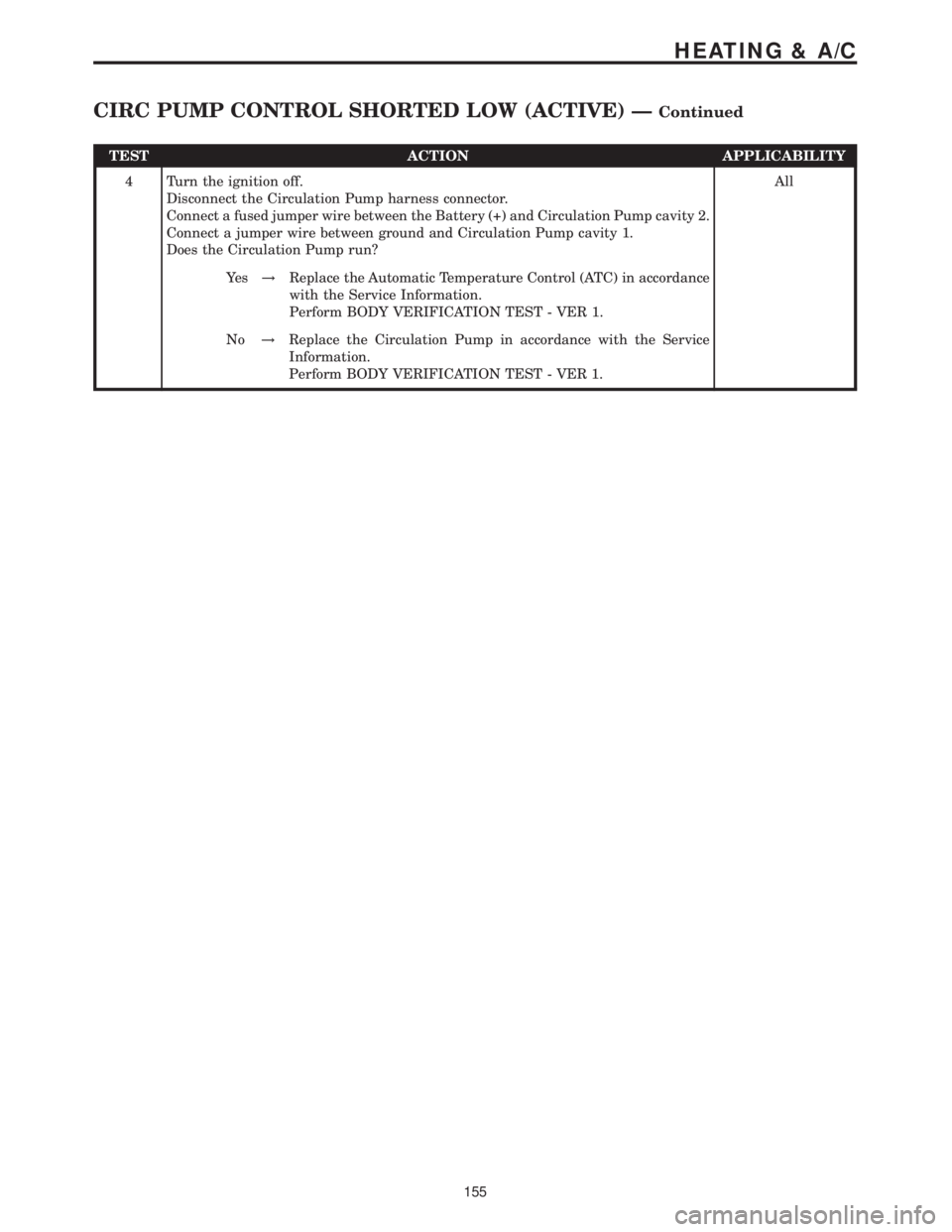
TEST ACTION APPLICABILITY
4 Turn the ignition off.
Disconnect the Circulation Pump harness connector.
Connect a fused jumper wire between the Battery (+) and Circulation Pump cavity 2.
Connect a jumper wire between ground and Circulation Pump cavity 1.
Does the Circulation Pump run?All
Ye s!Replace the Automatic Temperature Control (ATC) in accordance
with the Service Information.
Perform BODY VERIFICATION TEST - VER 1.
No!Replace the Circulation Pump in accordance with the Service
Information.
Perform BODY VERIFICATION TEST - VER 1.
155
HEATING & A/C
CIRC PUMP CONTROL SHORTED LOW (ACTIVE) ÐContinued
Page 222 of 2305
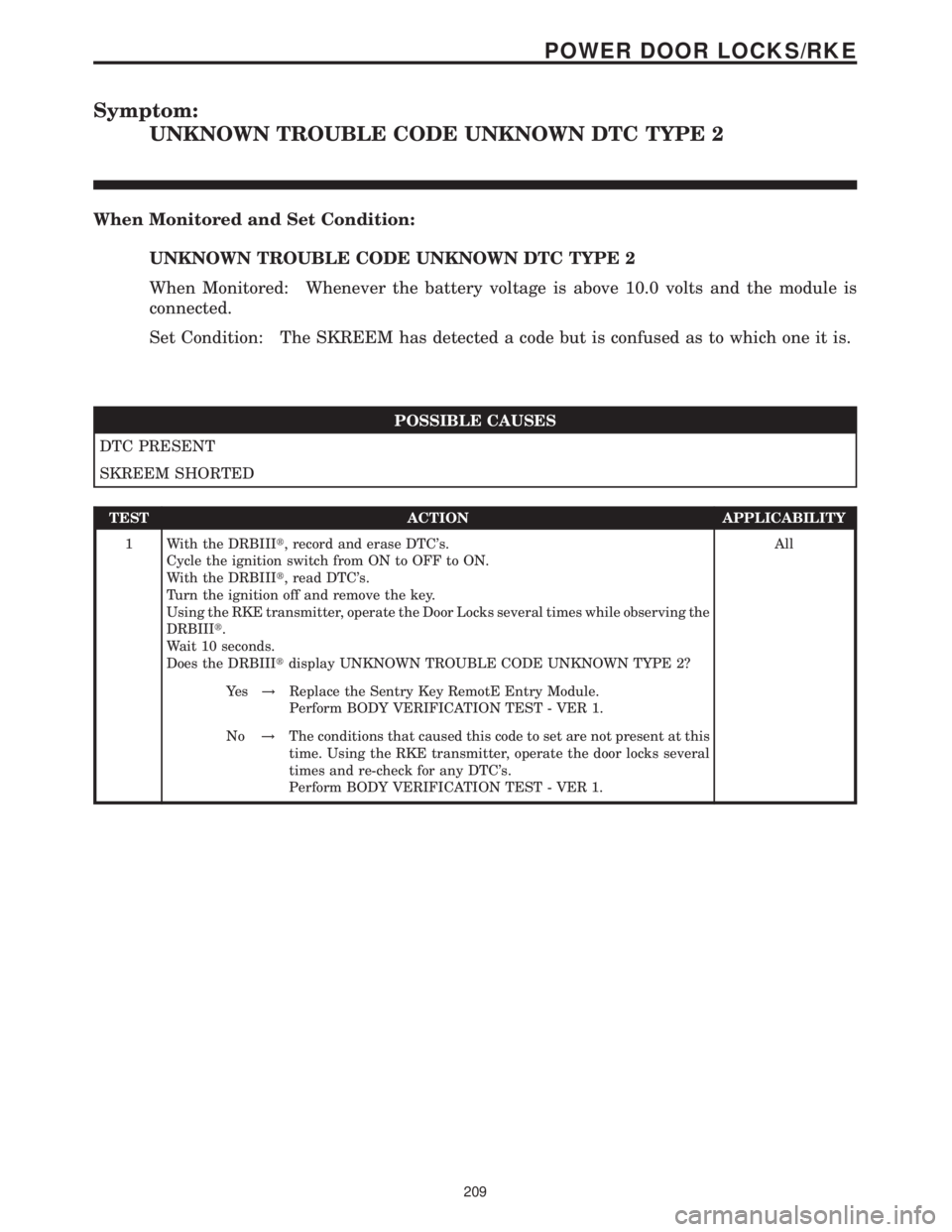
Symptom:
UNKNOWN TROUBLE CODE UNKNOWN DTC TYPE 2
When Monitored and Set Condition:
UNKNOWN TROUBLE CODE UNKNOWN DTC TYPE 2
When Monitored: Whenever the battery voltage is above 10.0 volts and the module is
connected.
Set Condition: The SKREEM has detected a code but is confused as to which one it is.
POSSIBLE CAUSES
DTC PRESENT
SKREEM SHORTED
TEST ACTION APPLICABILITY
1 With the DRBIIIt, record and erase DTC's.
Cycle the ignition switch from ON to OFF to ON.
With the DRBIIIt, read DTC's.
Turn the ignition off and remove the key.
Using the RKE transmitter, operate the Door Locks several times while observing the
DRBIIIt.
Wait 10 seconds.
Does the DRBIIItdisplay UNKNOWN TROUBLE CODE UNKNOWN TYPE 2?All
Ye s!Replace the Sentry Key RemotE Entry Module.
Perform BODY VERIFICATION TEST - VER 1.
No!The conditions that caused this code to set are not present at this
time. Using the RKE transmitter, operate the door locks several
times and re-check for any DTC's.
Perform BODY VERIFICATION TEST - VER 1.
209
POWER DOOR LOCKS/RKE
Page 233 of 2305

Symptom:
INTRUSION SENSOR 1 CIRCUIT OPEN/SHORT TO GROUND
When Monitored and Set Condition:
INTRUSION SENSOR 1 CIRCUIT OPEN/SHORT TO GROUND
When Monitored: Whenever the battery voltage is above 10.0 volts and the Security
System Module is connected.
Set Condition: The Security System Module detects the incorrect voltage on the Intrusion
Sensor circuit.
POSSIBLE CAUSES
DTC PRESENT
FUSE 2 IN FUSE BLOCK 3
FUSED B(+) WIRE OPEN
GROUND CIRCUIT OPEN
INTRUSION SENSOR 1 SIGNAL SHORTED
INTRUSION SENSOR 1 SIGNAL CIRCUIT OPEN
INTRUSION SENSOR INTERFACE WIRE SHORTED
INTRUSION SENSOR INTERFACE WIRE OPEN
INTRUSION SENSOR
TEST ACTION APPLICABILITY
1 With the DRBIIIt, record and erase DTC's.
Remove the ignition key.
Close and lock all doors and set the Vehicle Theft Security System.
Wait 1 minute.
Disarm the Vehicle Theft System.
With the DRBIIIt, read DTC's.
Does the DRBIIItdisplay the same DTC?All
Ye s!Go To 2
No!Using the wiring diagram/schematic as a guide, inspect the
wiring and connectors for an intermittent condition.
Perform BODY VERIFICATION TEST - VER 1.
2 Check Fuse 2 in Fuse Block 3.
Is the fuse open?All
Ye s!Check for a short to ground and replace the fuse.
Perform BODY VERIFICATION TEST - VER 1.
No!Go To 3
220
VEHICLE THEFT/SECURITY